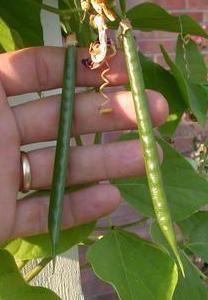Vigna caracalla
| Habit | vine-climber
| |
|---|---|---|
| Lifespan: | ⌛ | perennial |
| Exposure: | ☼ | sun |
|---|---|---|
| Water: | ◍ | moist |
| Features: | ✓ | flowers, fragrance |
| USDA Zones: | 9 to 12 | |
| Flower features: | ❀ | purple |
|
Fabaceae > |
Vigna > |
Vigna caracalla is leguminous vine from the family Fabaceae, originating in tropical South America and Central America. The species is named caracalla, meaning that it comes from Caracas in Venezuela.
That this perennial vine has fragrant flowers is a common misconception (though there may be hybrid varieties as such) - said to be reminiscent of hyacinths - with a distinctive curled shape, giving rise to the common names corkscrew vine, snail vine or snail bean.
This vine is hardy in zones 9 and above, liking full sun and consistently damp soil. It prefers high heat and humidity and can become invasive if these conditions are met. In lower (colder) zones, it does well in a pot if it is overwintered inside.
Some data indicates some edible properties to this plant - specifically the flowers - but this should be verified from a reputable source before attempting.
Read about Vigna caracalla in the Standard Cyclopedia of Horticulture
|
|---|
|
Phaseolus Caracalla, Linn. Caracol. Snail-flower. Corkscrew-flower. Lfts.broadly rhombic-ovate, pointed or acuminate: fls. large and fleshy, very fragrant, the large keel coiled like a snail-shell. Tropics, probably of the Old World.— Naturalized in parts of Calif., where it grows 20 or more ft. high, sometimes becoming a nuisance. It is an old-fashioned glasshouse plant in cold climates, but is now rarely seen. P. Bertonii, Hort., recently intro. from Paraguay, although a close relative, is probably specifically distinct from P. Caracalla. CH
|
Cultivation
- Do you have cultivation info on this plant? Edit this section!
Propagation
- Do you have propagation info on this plant? Edit this section!
Pests and diseases
- Do you have pest and disease info on this plant? Edit this section!
Species
Gallery
If you have a photo of this plant, please upload it! Plus, there may be other photos available for you to add.
References
- Standard Cyclopedia of Horticulture, by L. H. Bailey, MacMillan Co., 1963
External links
- w:Vigna caracalla. Some of the material on this page may be from Wikipedia, under the Creative Commons license.
- Vigna caracalla QR Code (Size 50, 100, 200, 500)


